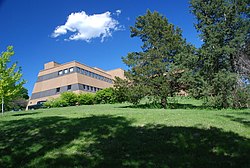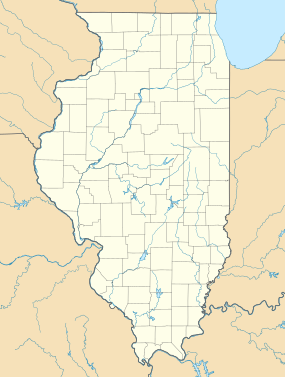Dickson Mounds

Museum at the site
|
|
| Location |
Lewistown, Illinois, Fulton County, Illinois, |
|---|---|
| Region | Fulton County, Illinois |
| Coordinates | 40°21′2.16″N 90°6′57.24″W / 40.3506000°N 90.1159000°W |
| History | |
| Founded | 800 CE |
| Abandoned | 1250 CE |
| Cultures | Middle Mississippian culture |
| Site notes | |
| Excavation dates | 1937 |
| Architecture | |
| Architectural styles | burial mounds, platform mound |
| Architectural details | Number of monuments: |
|
Dickson Mounds
|
|
| NRHP Reference # | 72000457 |
| Added to NRHP | May 5, 1972 |
| Responsible body: State of Illinois | |
Dickson Mounds is a Native American settlement site and burial mound complex near Lewistown, Illinois. It is located in Fulton County on a low bluff overlooking the Illinois River. It is a large burial complex containing at least two cemeteries, ten superimposed burial mounds, and a platform mound. The Dickson Mounds site was founded by 800 CE and was in use until after 1250 CE. The site is named in honor of chiropractor Don Dickson, who began excavating it in 1927 and opened a private museum that formerly operated on the site.
Don Dickson was a chiropractor and discovered the burial mounds on his family farm. Instead of removing the bones, he only removed the dirt. He covered his excavation with a tent. He later replaced his tent with a building and set up a private museum.
The Dickson Mounds Museum is a museum erected on the site in 1972 by the U.S. state of Illinois; it describes the life cycles and culture of Native Americans living in the Illinois River valley over a period of 12,000 years since the last Ice Age. The museum is part of the Illinois State Museum system.
While the members of most hunter-gatherer cultures travel extensively or even practice a nomadic lifestyle, the exceptional productivity of the Illinois River valley in fish, shellfish and game made it possible for semi-permanent settlements to develop. Archaeological examination of these sites have generated significant insights into the living conditions of Native Americans over time and the levels of technology they possessed.
A large parcel of the adjacent river bottomland is undergoing preservation and ecosystem restoration as part of the Emiquon Project. The Emiquon wetlands generated much of the food eaten by the people who lived on or near this blufftop site. In 2009, an excavation by Michigan State University turned up sherds of pottery, arrowheads and the foundations of houses and other structures that date back to about 1300 CE.
...
Wikipedia

